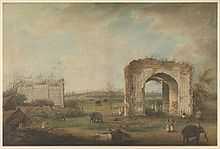Motijhil
Coordinates: 24°09′37″N 88°16′55″E / 24.160324°N 88.282002°E
| Motijhil | |
|---|---|
 A painting showing the Sang-i- dalan, Kala Masjid, the tombs all surrounded by the Motijhil Lake. | |
| Location | Murshidabad |
| Coordinates | 24°09′37″N 88°16′55″E / 24.160324°N 88.282002°E |
| References | "Website of Motijhil". |
Motijhil (also Motijheel, translation: Pearl Lake) is a horse-shoe shaped lake in Murshidabad, West Bengal, India. It was created by Nawazish Muhammad Khan, the son-in-law of Nawab Alivardi Khan. He constructed a precious palatial palace beside this lake which is called the Sang-i- dalan ("stone palace") which is also known as the Motijhil Palace. It is located at the bend of this lake. It was used as the residence of Nawazish and Ghaseti Begum, Nawazish's beloved wife. With this money he built a similar lake with a beautiful palace, Hirajheel, on the opposite side of the Bhagirathi River. The palace has a lofty gateway, a mosque known as the "Shahamat Jang" and the Kala Masjid and some other buildings which were all built by Nawazish. This palace was built in 1740. This palace was then decorated with different varieties of flower plants and precious marbles. Inside the palace is a huge room having no doors or windows in it and closed on all the four sides. Some say that huge quantity of wealth belonging to the Begum had been kept hidden underneath the room. Once labours were employed to break open the masonry and excavate the treasure, but they ended up vomiting blood, so nobody dares to open it. The room is 65 feet long, 23 feet broad, 12 feet high plinth area, 1339 square feet.

It has been excavated on the former beds of the Bhagirathi River that once flowed near this lake. The river was much nearer in 1766 that now. At south there is a tank known as the Shanti Pukur. The offices were built on its banks.
Motijheel was also the residence of Warren Hastings, Sir John Shore and other British high-ranking officials. So, it is also known as the Company Bagh due to its association with the East India Company.[1] Motijhi was the home of Warren Hastings when he became the political president at the Durbar of the Nawab Nazim. John Shore is said to have appreciated the "cooing doves, whistling blackbirds and purling streams".
Kala Masjid

The plinth area of the mosque is 5986 square feet.

Opposite this masjid on the east banks of the lake was an ornamented mosque called the Raesh Bagh.
Tombs

Here is the grave of the son of Mr. Keating, Edward Keating. Keating in 1794 was the superintendent of the Murshidabad Mint and rose to judge of the court of appeal. It has been confirmed by a slab embedded on the grave. His son was born on December 20, 1779 and died on March 3, 1785 (age 5 years, 2 months and 11 days).
New constructions
In 1758, after Siraj ud-Daulah's defeat in at the Battle of Plassey, Mir Jafar constructed a palace with 12 doors here and named it Bara Duari ('the palace with 12 doors'). Several English men like Lord Curzon lived here to neogitate with the Nawabs for the transfer of the Dewani to the East India Company. He on the 29th of that month held the first English ceremony for commencing the revenue collections; then Lord Curzon was the Dewan and Nizam-ud-Daula was the Nawab Nazim.
References
External links
| Wikimedia Commons has media related to Motijhil. |
| ||||||||||||||||||||||||||

